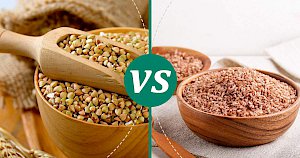Brown Rice vs Buckwheat: Nutrition & Calories Compare


Brown rice vs Buckwheat
Nutrition Facts
Serving size:
change
5g10g15g20g30g40g50g60g80g100g120g140g160g180g200g220g250g300g350g400g450g500g600g700g800g900g1000g
1oz2oz3oz4oz5oz6oz7oz8oz10oz12oz15oz20oz25oz30oz35oz40oz50oz
Amount Per Serving:
Serving size:
change
5g10g15g20g30g40g50g60g80g100g120g140g160g180g200g220g250g300g350g400g450g500g600g700g800g900g1000g
1oz2oz3oz4oz5oz6oz7oz8oz10oz12oz15oz20oz25oz30oz35oz40oz50oz
Amount Per Serving:
Brown Rice vs Buckwheat 100g Compare
| per 100g | Brown rice | Buckwheat |
|---|---|---|
| Calories | 370 | 343 |
| Carbohydrates | 78.68 g | 71.13 g |
| Fat | 2.75 g | 3.04 g |
| Saturated fat | 0.49 g | 0.2 g |
| Dietary fiber | 3.5 g | 4.05 g |
| Protein | 7.6 g | 11.07 g |
| Water | 9.82 g | 12.95 g |
| Calcium | 8 mg | 13.64 mg |
| Iron | 1.16 mg | 2.444 mg |
| Magnessium | 98 mg | 203 mg |
| Potassium | 219 mg | 414.5 mg |
| Vitaminium B1 (Thiamine) | 0.277 mg | 0.539 mg |
| Vitaminium B2 (riboflavin) | 0.092 mg | 0.178 mg |
| Vitaminium B3 (Niacin) | 4.973 mg | 5.366 mg |
| Vitaminium B6 | 0.407 mg | 0.278 mg |
| Vitaminium B9 (Folic acid) | 0.014 mg | 30 mg |
Discovering the Unique Benefits of Brown Rice and Buckwheat
When it comes to choosing whole grains, brown rice and buckwheat stand out for their distinctive benefits and nutritional profiles. While brown rice is a well-known staple in many diets around the world, celebrated for its versatility and nutty flavor, buckwheat is a lesser-known but equally nutritious option that offers a range of health benefits. Beyond just their nutritional content, both grains have interesting backstories and uses that might surprise you.
A Closer Look at Brown Rice
Brown rice, unlike its white counterpart, retains the bran and germ layer after processing, which is why it boasts a higher fiber content and a more robust flavor. This whole grain is not just a side dish; it's a cultural staple in many parts of the world, playing a central role in various traditional dishes. Its versatility allows it to be incorporated into everything from sushi to risotto, showcasing its ability to adapt to different culinary traditions.
The Versatile World of Buckwheat
Buckwheat, despite its name, is not a type of wheat at all. It's a pseudocereal, related more closely to rhubarb than to wheat, and is naturally gluten-free. This makes it an excellent grain alternative for those with gluten sensitivities or celiac disease. Buckwheat is often ground into flour and used in everything from pancakes to noodles, known as soba in Japan. Its earthy flavor and high nutritional value have made it a favored ingredient in many cultures.
Nutritional Profiles: More Than Just the Numbers
When comparing the nutritional data of brown rice and buckwheat, it's clear that both have their advantages. Brown rice provides a good source of magnesium, vitamins B3, and phosphorus, making it a heart-healthy option that can support good digestion due to its fiber content. On the other hand, buckwheat is a powerhouse of nutrients, offering higher levels of fiber, protein, and essential minerals like magnesium, iron, and phosphorus than brown rice. It's particularly noted for its high antioxidant content, including rutin, which can support blood circulation and lower cholesterol levels.
Nutritional Highlights:- Fiber: Buckwheat contains significantly more fiber than brown rice, which can aid in digestion and provide a feeling of fullness.
- Protein: With a higher protein content, buckwheat is an excellent choice for vegetarians and those looking to increase their protein intake from plant-based sources.
- Minerals: Buckwheat is rich in magnesium and iron, essential for energy production and oxygen transport in the body, respectively.
Choosing Between Brown Rice and Buckwheat
The choice between brown rice and buckwheat ultimately depends on personal dietary needs and taste preferences. Brown rice may be more appealing to those who prefer a milder flavor and a grain that can easily blend into a variety of dishes. It's also slightly easier to cook and more readily available in many parts of the world.
Buckwheat, with its robust nutritional profile and gluten-free status, is an excellent choice for those looking to boost their intake of fiber and essential minerals or those who need to avoid gluten. Its unique flavor and texture make it a versatile ingredient in both savory and sweet dishes.
Both brown rice and buckwheat offer distinct health benefits and culinary uses, making them valuable additions to a balanced diet. Whether you're looking for a nutritious base for your meals or a gluten-free grain alternative, exploring the unique qualities of each can enrich your diet and introduce you to new and flavorful dishes.
Brown rice 100g
370kcalCalories source
- 85% CARBS.
- 8% PROTEIN
- 7% FAT
Buckwheat 100g
343kcalCalories source
- 80% CARBS
- 12% PROTEIN
- 8% FAT
Compares of brown rice
- Brown Rice vs Buckwheat
- Brown Rice vs Millet
- Brown Rice vs Oats
- Brown Rice vs Wild Rice
- Brown Rice vs Black Beans
- Brown Rice vs Red Lentils
- see all compares of brown rice
Compares of buckwheat
Read also:
- Calories from Brown rice
- Calories of Breakfast sausage
- Calories in Chocolate covered almond
- Vegetable soup calories per 100g
- Cooked pinto beans protein per 100g
- How many calories does dark chocolate have?
- Calories in tablespoon of Swiss cheese
- Calories in teaspoon of Swiss cheese
- Calories in slice of Swiss cheese
- How much protein in margarine?
Marcin Piotrowicz
calories-info.com creator
Healthy diet and healthy lifestyle promoter
Add comment